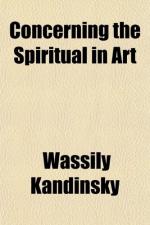Blue is the typical heavenly colour.
[Footnote: ...The halos are golden for emperors and prophets (i.e. for mortals), and sky-blue for symbolic figures (i.e. spiritual beings); (Kondakoff, Histoire de l’An Byzantine consideree principalement dans les miniatures, vol. ii, p. 382, Paris, 1886-91).]
The ultimate feeling it creates is one of rest.
[Footnote: Supernatural rest, not the earthly contentment of green. The way to the supernatural lies through the natural. And we mortals passing from the earthly yellow to the heavenly blue must pass through green.]
When it sinks almost to black, it echoes a grief that is hardly human.
[Footnote: As an echo of grief violet stand to blue as does green in its production of rest.]
When it rises towards white, a movement little suited to it, its appeal to men grows weaker and more distant. In music a light blue is like a flute, a darker blue a cello; a still darker a thunderous double bass; and the darkest blue of all-an organ.
A well-balanced mixture of blue and yellow produces green. The horizontal movement ceases; likewise that from and towards the centre. The effect on the soul through the eye is therefore motionless. This is a fact recognized not only by opticians but by the world. Green is the most restful colour that exists. On exhausted men this restfulness has a beneficial effect, but after a time it becomes wearisome. Pictures painted in shades of green are passive and tend to be wearisome; this contrasts with the active warmth of yellow or the active coolness of blue. In the hierarchy of colours green is the “bourgeoisie"-self-satisfied, immovable, narrow. It is the colour of summer, the period when nature is resting from the storms of winter and the productive energy of spring (cf. Fig. 2).
Any preponderance in green of yellow or blue introduces a corresponding activity and changes the inner appeal. The green keeps its characteristic equanimity and restfulness, the former increasing with the inclination to lightness, the latter with the inclination to depth. In music the absolute green is represented by the placid, middle notes of a violin.
Black and white have already been discussed in general terms. More particularly speaking, white, although often considered as no colour (a theory largely due to the Impressionists, who saw no white in nature as a symbol of a world from which all colour as a definite attribute has disappeared).
[Footnote: Van Gogh, in his letters, asks whether he may not paint a white wall dead white. This question offers no difficulty to the non-representative artist who is concerned only with the inner harmony of colour. But to the impressionist-realist it seems a bold liberty to take with nature. To him it seems as outrageous as his own change from brown shadows to blue seemed to his contemporaries. Van Gogh’s question marks a transition from Impressionism to an art of spiritual harmony, as the coming of the blue shadow marked a transition from academism to Impressionism. (Cf. The Letters of Vincent van Gogh. Constable, London.)]




